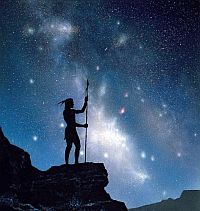


|
|
The Milky WayStar LorePart 2 - North America |
|


The Milky Way is our home galaxy. Our sun is one of an estimated
100 to 400 billion stars in this galaxy.
 Before the invention of the telescope, the Milky Way was observed only as a hazy band of light in which no individual stars could be distinguished. This mythical band is the source of many myth around the world.  In most Native North american cultures, is is seen as a path taken by the spirits. |


|
|
Apache
In Volume 1 of his epic 20-volume work The North American Indian,
US-American ethnologist Edward S. Curtis describes the association of the Apache people with
the Milky Way.
|
 Native American and Milky Way
Native American and Milky Way© John R. Foster / Science Source |


|
|
Cherokee
The Cherokee have a story about How The Milky Way Came To Be.
|
 The Origin of the Milky Way
Source: kobo.com
The Origin of the Milky Way
Source: kobo.com
|
Then they noticed that the cornmeal was scattered over the ground. In the middle of the spilled meal were giant dog prints! These dog prints were so
large that they knew this was no ordinary dog.
 The elderly couple immediately alerted the people of the village. The village held council. It was decided that this must be a spirit dog from another world! The people did not want the spirit dog coming to their village, so they decided to get rid of the dog by frightening it so bad it would never return. They gathered their drums and turtle shell rattles and later that night they hid around the area where the cornmeal was kept.  Late into the night, they heard a whirring sound like many bird wings. They looked up to see the form of a giant dog swooping down from the sky. It landed near the basket and then began to eat great mouthfuls of cornmeal. |

Suddenly the people jumped up beating and shaking their noise makers. The noise was so loud it sounded like thunder! The giant dog turned and began
to run down the path. The people chased after him making the loudest noises they could. That dog ran to the top of a hill and leaped into the sky,
the cornmeal spilling out the sides of its mouth.
 The giant dog ran across the black night sky until it disappeared from sight...but the cornmeal that had spilled from its mouth made a pathway across the sky. Each grain of cornmeal became a star.  The Cherokees call that pattern of stars, gi li' ut sun stan un' yi, "the place where the dog ran."  And that is how the Milky Way came to be.  Source: powersource.com |
  Spirit Dog
Source: amazon.com
Spirit Dog
Source: amazon.com
|


|
|
Chumash
For the Chumash at the southern California coast, the common name of the milky was was "Journey of the Piñon Gatheres." Both the Milky Way and
the inside of the piñon nut are white. In late fall and early winter, the Milky Way symbolized the northward journey the Chumash made to gather
ripe piñon nuts. Near the constellation Cygnus, the Milky Way seemingly splits
and appears to follow two paths, which in winter are just visible on the western horizon after sunset.
|
 Piñon Pine Nuts
Piñon Pine NutsSource: gardeningknowhow.com
|


|
|
Lakota
In his book Sioux Life & Customs Of A Warrior Society,
Royal B. Hassrick describes how the Lakota, a major subgroup of the Sioux, interpreted the Milky Way.
|
 Lakota Tipi and Milky Way;
imagefinder.co
Lakota Tipi and Milky Way;
imagefinder.co
|
William K. Powers, in his book Oglala Religion,
adds a facette to the story, focussing on the Oglala, one of the seven sub-tribes of the Lakota.
 Powers describes that the Oglala spirits too had to pass the old woman, but adds, that the woman would judges the spirit's life on earth and would either sends it on or would send it back to earth where it had to exist as a shade.  The Oglala called the Milky Way Wanagi Tacanku, the Spirit Road and believed that the light of the Milky Way originated from the campfires of the traveling spirits.  Source: native-science.net |


|
|
Navajo
Yikáísdáhá, That Which Awaits the Dawn, is related to the annual Milky Way process. The emergence of pre-dawn is determined by the position of
the Milky Way that changes with the nights, months and seasons.
|
 Yikáísdáhá © Melvin Bainbridge
Yikáísdáhá © Melvin Bainbridge
|


|
|
Ojibwe
The Ojibwe people called the MilkyWay Jiibay Ziibi, the River of Souls.
|
 River of Souls
River of Souls© Carl Gawboy |


|

|


|
|
Shoshone
In Volume 15 of his 20-volume work The North American Indian,
US-American ethnologist Edward S. Curtis describes the Shoshone, who live in what is now Wyoming,
Idaho, Utah and Nevada.
|


 |
Back to Europe, Middle East, Asia | Forward to Southern Hemisphere |
 |


|
Back to Star Lore |
Back to Mythology |

Back to Milky Way |
Back to Space Page |
Back to English |
 Back to Start Page |